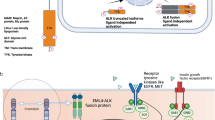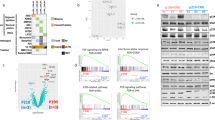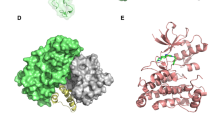Abstract
Mutant forms of the c-ABL gene are well known to be involved in hematopoietic malignancies such as chronic myeloid leukemia (CML). CML patients possess a fused BCR-ABL gene that activates the Abl tyrosine kinase domain within Bcr-Abl. In general fusion proteins that cause oligomerization of Abl lead to activation of its tyrosine kinase activity. In this review, we highlight recent discoveries indicating that the activated c-Abl tyrosine kinase, not as a fusion protein, plays an important role in malignant solid tumors of lung and breast.
This is a preview of subscription content, access via your institution
Access options
Subscribe to this journal
Receive 50 print issues and online access
$259.00 per year
only $5.18 per issue
Buy this article
- Purchase on Springer Link
- Instant access to full article PDF
Prices may be subject to local taxes which are calculated during checkout



Similar content being viewed by others
References
Buchdunger E, Zimmerman J, Mett H, Meyer T, Muller M, Druker B et al. (1996). Inhibition of the Abl protein-tyrosine kinase in vitro and in vivo by a 2-phenylaminopyrimidine derivative. Cancer Res 56: 100–104.
Bunn P, Franklin W . (2002). Epidermal growth factor receptor expression, signal pathway, and inhibitors in non-small cell lung cancer. Semin Oncol 29 (5 Suppl 14): 38–44.
Dowell J, Minna J . (2005). Chasing mutations in the epidermal growth factor in lung cancer. N Engl J Med 352: 830–832.
Girard L, Zochbauer-Muller S, Virmani A, Gazdar A, Minna J . (2000). Genome-wide allelotyping of lung cancer identifies new regions of allelic loss, differences between small cell lung cancer and non-small cell lung cancer, and loci clustering. Cancer Res 60: 4894–4906.
Hantschel O, Nagar B, Guettler S, Kretzschmar J, Dorey K, Kuryian J et al. (2003). A myristoyl/phosphotyrosine switch regulates c-Abl. Cell 112: 845–857.
Ito I, Ji L, Tanaka F, Saito Y, Gopalan B, Branch C et al. (2004). Liposomal vector mediated delivery of the 3p FUS1 gene demonstrates potent antitumor activity against human lung cancer in vivo. Cancer Gene Ther 11: 1–7.
Ji L, Nishizaki M, Gao B, Burbee D, Kondo M, Kamibayashi C et al. (2002). Expression of several genes in the human chromosome 3p21.3 homozygous deletion region by an adenovirus vector results in tumor suppressor activities in vitro and in vivo. Cancer Res 62: 2715–2720.
Kondo M, Ji L, Kamibayashi C, Tomizawa Y, Randle D, Sekido Y et al. (2001). Overexpression of candidate tumor suppressor gene FUS1 isolated from the 3p21.3 homozygous deletion region leads to G1 arrest and growth inhibition of lung cancer cells. Oncogene 20: 6258–6262.
LeRoith D, Werner H, Beitner-Johnson D, Roberts C . (1995). Molecular and cellular aspects of the insulin-like growth factor I receptor. Endocr Rev 16: 143–163.
Lin J, Sun T, Ji L, Deng W, Roth J, Minna J et al. (2007). Oncogenic activation of c-Abl in non-small cell lung cancer cells lacking FUS1 expression: inhibition of c-Abl by the tumor suppressor gene product Fus1. Oncogene 26: 6989–6996.
Lin J, Sun T, Lin J, Minna J, Roth J, Arlinghaus R . (2005). Activated c-Abl in FUS1 haploinsufficient non-small cell lung carcinoma. 96th Annual American Association for Cancer Research (Abstract 2877).
Ling X, Ma G, Sun T, Liu J, Arlinghaus R . (2003). Bcr and Abl interaction: oncogenic activation of c-Abl by sequestering Bcr. Cancer Res 63: 298–303.
Liu J, Wu Y, Arlinghaus R . (1996). Sequences within the first exon of BCR inhibit the activated tyrosine kinases of c-Abl and the Bcr-Abl oncoprotein. Cancer Res 56: 5120–5124.
Ma Z, Dong A, Kong M, Qian J . (2007). Silencing of the type 1 insulin-like growth factor receptor increases the sensitivity to apotosis and inhibits invasion in human lung adenocarcinoma A549 cells. Cell Mol Biol Lett 12: 556–572.
Miller C, Chen G, Gharib T, Wang H, Thomas D, Misek D et al. (2003). Increased C-CRK proto-oncogene expression is associated with an aggressive phenotype in lung adenocarcinomas. Oncogene 22: 7950–7957.
Negri T, Casieri P, Miselli F, Orsenigo M, Piacenza C, Stacchiotti S et al. (2007). Evidence for PDGFR-α, PDGFR-β and KIT deregulation in an NSCLC patient. Br J Cancer 96: 180–181.
Osherov N, Levitzki A . (1994). Epidermal-growth-factor-dependent activation of the Src-family kinases. Eur J Biochem 225: 1047–1053.
Pendergast A . (2002). The Abl family kinases: mechanisms of regulation and signaling. Adv Cancer Res 85: 51–100.
Plattner R, Kadlec L, DeMali K, Kazlauskas A, Pendergast A . (1999). c-Abl is activated by growth factors and Src family kinases and has a role in the cellular response to PDGF. Genes Dev 13: 2400–2411.
Plattner R, Pendergast AM . (2003). Activation and signaling of the Abl tyrosine kinase: bidirectional link with phosphoinositide signaling. Cell Cycle 2: 273–274.
Pluk H, Dorey K, Superti-Furga G . (2002). Autoinhibition of c-Abl. Cell 108: 247–259.
Prudkin L, Behrens C, Liu D, Zhou X, Ozburn N, Bekele B et al. (2008). Loss and reduction of Fus1 protein expression is a frequent phenomenon in the pathogenesis of lung cancer. Hum Cancer Biol 14: 41–47.
Ross S, Fletcher A . (1998). The HER-2/neu oncogene in breast cancer: prognostic factor, predictive factor, and target for therapy. Stem Cells 16: 413–428.
Sirvent A, Boureux A, Simon V, Leroy C, Roche S . (2007). The tyrosine kinase Abl is required for Src-transforming activity in mouse fibroblasts and human breast cancer cell lines. Oncogene 26: 7313–7323.
Srinivasan D, Plattner R . (2006). Activation of Abl tyrosine kinases promotes invasion of aggressive breast cancer cells. Cancer Res 66: 5648–5655.
Srinivasan D, Sims J, Plattner R . (2008). Aggressive breast cancer cells are dependent on activated Abl kinases for proliferation, anchorage-independent growth and survival. Oncogene 27: 1095–1105.
Taagepera S, McDonald D, Loeb J, Whitaker L, McElroy A, Wang J et al. (1998). Nuclear-cytoplasmic shuttling of C-ABL tyrosine kinase. Proc Natl Acad Sci USA 95: 7457–7462.
Tanos B, Pendergast AM . (2006). Abl tyrosine kinase regulates endocytosis of the epidermal growth factor receptor. J Biol Chem 28: 32714–32723.
Uno F, Sasaki J, Nishizaki M, Carboni G, Xu K, Atkinson E et al. (2004). Myristoylation of the fus1 protein is required for tumor suppression in human lung cancer cells. Cancer Res 64: 2969–2976.
U.S. Cancer Statistics Working Group (2004). U.S. Cancer Statistics: 2001 Incidence and Mortality. U.S. Department of Health and Human Services, Centers for Disease Control and Prevention and National Cancer Institute: Atlanta.
Vlahovic G, Rabbani Z, Herndon II J, Dewhirst M, Vujaskovic Z . (2006). Treatment with imatinib in NSCLC is associated with decrease if phosphorylated PDGFR-β and VEGF expression, decrease in interstitial fluid pressure and improvement of oxygenation. Br J Cancer 95: 1013–1019.
Wang J . (2000). Regulation of cell death by the Abl tyrosine kinase. Oncogene 19: 5643–5650.
Wen S, Van Etten R . (1997). The PAG gene product, a stress-induced protein with antioxidant properties, is an Abl SH3-binding protein and a physiological inhibitor of c-Abl tyrosine kinase activity. Genes Dev 11: 2456–2467.
Woodring P, Hunter T, Wang J . (2003). Regulation of F-actin-dependent processes by the Abl family of tyrosine kinases. J Cell Science 116 (Part 13): 2613–2626.
Zabarovsky E, Lerman M, Minna J . (2002). Tumor suppressor genes on chromosome 3p involved in the pathogenesis of lung and other cancers. Oncogene 21: 6915–6935.
Zhang P, Gao W, Turner S, Ducatman B . (2003). Gleevec (STI-571) inhibits lung cancer cell growth (A549) and potentiates the cisplatin effect in vitro. Mol Cancer 2: 1.
Author information
Authors and Affiliations
Corresponding author
Rights and permissions
About this article
Cite this article
Lin, J., Arlinghaus, R. Activated c-Abl tyrosine kinase in malignant solid tumors. Oncogene 27, 4385–4391 (2008). https://doi.org/10.1038/onc.2008.86
Published:
Issue Date:
DOI: https://doi.org/10.1038/onc.2008.86
Keywords
This article is cited by
-
Mitochondrial Fus1/Tusc2 and cellular Ca2+ homeostasis: tumor suppressor, anti-inflammatory and anti-aging implications
Cancer Gene Therapy (2022)
-
Molecular modeling piloted analysis for semicarbazone derivative of curcumin as a potent Abl-kinase inhibitor targeting colon cancer
3 Biotech (2021)
-
Atomic view of the energy landscape in the allosteric regulation of Abl kinase
Nature Structural & Molecular Biology (2017)
-
Tyrosine kinase c-Abl regulates the survival of plasma cells
Scientific Reports (2017)
-
The LncRNA HOTAIR-expression, regulation and function in cancer
The Nucleus (2017)



